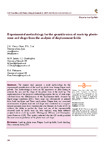Experimental methodology for the quantification of crack tip plastic zone and shape from the analysis of displacement fields
| dc.contributor.author | Vasco-Olmo, JM | |
| dc.contributor.author | Diaz, FA | |
| dc.contributor.author | James, Neil | |
| dc.contributor.author | Christopher, Colin | |
| dc.contributor.author | Patterson, EA | |
| dc.date.accessioned | 2018-01-09T10:09:49Z | |
| dc.date.available | 2018-01-09T10:09:49Z | |
| dc.date.issued | 2017-01-01 | |
| dc.identifier.issn | 1971-8993 | |
| dc.identifier.issn | 1971-8993 | |
| dc.identifier.uri | http://hdl.handle.net/10026.1/10507 | |
| dc.description.abstract |
The current work presents a novel methodology for the experimental quantification of the crack tip plastic zone during fatigue crack growth. This methodology is based on the application of yield criteria to estimate the area and the shape of the plastic zone at the crack tip. The implementation of the proposed methodology requires the use of strain maps calculated from the differentiation of the displacement fields obtained by digital image correlation (DIC). Stress maps can subsequently be inferred from both von Mises and Tresca yield criteria. Fatigue tests and associated measurements of plastic zone size and shape were conducted on a compact-tension specimen made from commercially pure titanium at R ratio of 0.6. In addition, the ability to predict the shape and size of the experimentally observed crack tip plastic zone has been explored using three different analytical elastic crack tip models [Westergaard, Williams and Christopher-James-Patterson (CJP)]. This analysis indicated that the CJP model provided the most accurate prediction of the plastic zone and shape. | |
| dc.format.extent | 166-174 | |
| dc.language.iso | en | |
| dc.publisher | Gruppo Italiano Frattura | |
| dc.title | Experimental methodology for the quantification of crack tip plastic zone and shape from the analysis of displacement fields | |
| dc.type | journal-article | |
| dc.type | Journal Article | |
| plymouth.issue | 41 | |
| plymouth.volume | 11 | |
| plymouth.publication-status | Published online | |
| plymouth.journal | Frattura ed Integrità Strutturale | |
| dc.identifier.doi | 10.3221/igf-esis.41.23 | |
| plymouth.organisational-group | /Plymouth | |
| plymouth.organisational-group | /Plymouth/Faculty of Science and Engineering | |
| plymouth.organisational-group | /Plymouth/Faculty of Science and Engineering/School of Engineering, Computing and Mathematics | |
| plymouth.organisational-group | /Plymouth/REF 2021 Researchers by UoA | |
| plymouth.organisational-group | /Plymouth/REF 2021 Researchers by UoA/EXTENDED UoA 10 - Mathematical Sciences | |
| plymouth.organisational-group | /Plymouth/REF 2021 Researchers by UoA/UoA10 Mathematical Sciences | |
| plymouth.organisational-group | /Plymouth/Users by role | |
| plymouth.organisational-group | /Plymouth/Users by role/Academics | |
| dc.identifier.eissn | 1971-8993 | |
| dc.rights.embargoperiod | Not known | |
| rioxxterms.versionofrecord | 10.3221/igf-esis.41.23 | |
| rioxxterms.licenseref.uri | http://www.rioxx.net/licenses/all-rights-reserved | |
| rioxxterms.type | Journal Article/Review |


